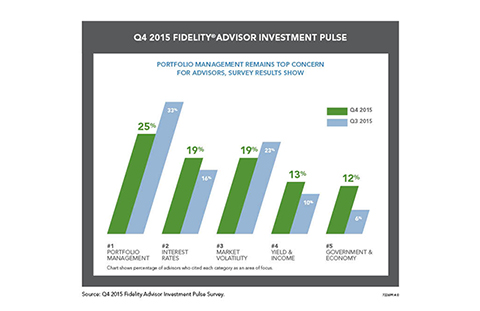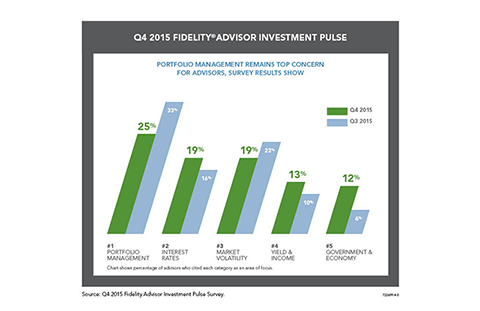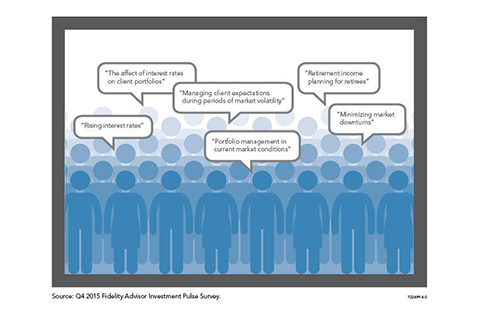BOSTON--(BUSINESS WIRE)--Portfolio management remained top-of-mind for financial advisors in Q4 2015, according to the latest Fidelity® Advisor Investment Pulse study. One-quarter of the advisors surveyed said the topic – which also took the No. 1 spot in Q3 – was an area of concern. Over the course of the second half of last year, portfolio management was more frequently cited as an area of focus than any other theme. The latest results of the survey were released today by Fidelity Institutional Asset Management, a distribution and client service organization dedicated to meeting the investment needs of financial advisors, institutions and consultants.
In their search for the ideal mix of risk and return, advisors may sometimes ignore the role of different time horizons in investing, even though they acknowledge it as important. This can contribute to the myth of there being one optimal portfolio.
“In reality, because markets are dynamic, an investment approach that works for one time horizon may potentially deliver a very different result for another,” said Scott E. Couto, head of distribution, Fidelity Institutional Asset Management. “Advisors may find it useful to frame their portfolio discussions with clients around multiple time horizons.”
Some advisors may already be looking at portfolios through a tactical lens (one to 12-month time frame), a period when geopolitics and consumer sentiment may push prices away from longer-term trends, as well a secular lens (10 to 30-year time frame), when demographic changes, productivity growth, and other economic trends that evolve over extended periods influence asset performance. This may not be sufficient.
Couto suggests that it is also important for advisors to consider the impact of the business cycle when trying to identify a balance between risk and return. This requires advisors to evaluate their clients’ portfolios over the intermediate term (one to 10 years), a period when asset performance is tied to economic factors such as corporate earnings, credit growth, and inventories. Today, most developed economies remain in the mid-cycle expansionary phase, when cyclical industries such as technology have historically performed well.
This is why framing portfolio discussions using not only the tactical and secular lenses, but also the cyclical lens, may help advisors develop a disciplined and differentiated approach to portfolio management. Advisors should consider setting their own guardrails around their secular, cyclical and tactical time horizons. Some advisors may update their secular views annually, their business cycle views weekly, and their tactical views on a daily basis.
Results from the Q4 2015 Fidelity Advisor Investment Pulse survey also showed that interest rates, market volatility, finding yield, and changes in the regulatory and macroeconomic environment continued to be important in the last quarter.
“Interest rates dominated business headlines for much of Q4, with the Fed moving to raise rates in December,” explained Couto. “That said, there were other important influences toward the end of last year and coming into this year. Market volatility has remained a significant concern, and an increasing number of advisors are keeping their eye on developments with the Department of Labor’s new fiduciary rule.”
“To make sense of the range of factors in play, many advisors are choosing to take a holistic, client-centric view. They want to understand how all these factors could affect their clients’ portfolios, and they want to be able to explain the potential impact to their clients,” added Couto.
When examining these other factors, advisors should challenge long-held myths, including avoiding bonds when rates rise. In reality, while interest rates may have risen, advisors may find it useful to evaluate credit risk as well as interest rate risk. A core of investment-grade bonds may help diversify equity risk, particularly in an environment where greater market volatility is a concern.
Resources for advisors
To address their concerns, Fidelity Institutional Asset Management offers a comprehensive program to arm advisors with original insights that can help support client discussions on portfolio management. The program aims to evolve the way advisors think about building portfolios, providing resources on current market dynamics, evaluating the impact of the business cycle on asset classes and sectors, the importance of active management in light of the new bond market, and how to approach manager selection given the overwhelming range of investment options available. To access the insights that Fidelity offers, and to demystify other portfolio construction myths, visit: advisor.fidelity.com/investmentpulse (for financial advisors only). Resources include:
- The Evolution of Portfolio Construction: Rethinking Time – Differentiate, protect, and grow your practice with Fidelity’s portfolio construction program, aimed at helping evolve your discussions with clients and prospects.
- Demonstrate Your Value to Clients – With a variety of financial guidance options available to investors, why should someone choose you as an advisor?
- Market Volatility: Fundamentals for Investors – While market volatility can be unsettling, volatile market behavior is not unusual. Two basic principles can help advisors navigate through volatility.
The Fidelity Advisor Investment Pulse is a survey that captures the investment topics on the minds of around 250 advisors in order to identify common concerns and deliver resources to help them navigate changing market conditions. Fidelity has been tracking advisor sentiment about investing concerns and opportunities since April 2012. This proprietary research enables Fidelity to provide advisors with timely perspectives from their peers, and offer tools to take advantage of the investment opportunities that exist today.
About the Fidelity Advisor Investment Pulse
The
Advisor Investment Pulse is an ongoing primary research effort that
captures the views of more than 1,000 Fidelity Institutional Asset
Management advisor clients annually. All Fidelity Institutional Asset
Management advisor clients in the broker-dealer and registered
investment advisor communities are asked to participate in the online
survey. These advisors serve a range of clients, including individual
investors, businesses, plan sponsors and institutions. Respondents are
asked an open-ended question: “Thinking about the investing environment
and outlook, and the potential impact on your client portfolios, what
investment challenge or opportunity would you say is top-of-mind for you
right now?”
The survey reports top-of-mind themes of most concern to financial advisors in both their practices and in the financial markets. These themes are distilled from individual financial advisor comments. The chart reflects the most current five themes that represent the most widely held views. Given the variability of the number of responses over time, and the ongoing nature of this effort, confidence levels will also be variable.
About Fidelity Investments
Fidelity’s
goal is to make financial expertise broadly accessible and effective in
helping people live the lives they want. With assets under
administration of $5.2 trillion, including managed assets of $2.1
trillion as of November 30, 2015, we focus on meeting the unique needs
of a diverse set of customers: helping more than 24 million people
invest their own life savings, nearly 20,000 businesses manage employee
benefit programs, as well as providing nearly 10,000 advisory firms with
technology solutions to invest their own clients’ money. Privately held
for nearly 70 years, Fidelity employs 42,000 associates who are focused
on the long-term success of our customers. For more information about
Fidelity Investments, visit https://www.fidelity.com/about.
Diversification does not ensure a profit or guarantee against a loss.
Investing involves risk, including risk of loss.
Past performance is no guarantee of future returns.
In general the bond market is volatile, and fixed-income securities carry interest rate risk. Fixed-income securities also carry inflation, credit, and default risks for both issuers and counterparties. Lower-quality bonds can be more volatile and have greater risk of default than higher-quality bonds.
Stock markets, especially foreign markets, are volatile and can decline significantly in response to adverse issuer, political, regulatory, market or economic developments. Foreign securities are subject to interest rate, currency exchange rate, economic and political risks. Changes in real estate values or economic downturns can have a significant negative effect on issuers in the real estate industry
Because of their narrow focus, sector securities tend to be more volatile than securities that diversify across many sectors and companies. Each sector funds are subject to the additional risks associated with its particular industry.
Asset allocation does not ensure a profit or guarantee against a loss. The ability of each fund to meet its investment objective is directly related to its target asset allocation among the underlying funds and the ability of those funds to meet their investment objectives.
The third-party trademarks and service marks are the property of their respective owners. All other trademarks and service marks are the property of FMR LLC or an affiliated company.
Fidelity Institutional Wealth Services provides brokerage products and services and is a division of Fidelity Brokerage Services LLC. Fidelity Brokerage Services LLC, Member NYSE, SIPC, 900 Salem Street, Smithfield, RI 02917.
National Financial is a division of National Financial Services LLC through which clearing, custody and other brokerage services may be provided. Both members NYSE, SIPC. 200 Seaport Boulevard Boston, MA 02210.
Products and services provided through Fidelity Institutional Asset Management (FIAM) to investment professionals, plan sponsors and institutional investors by Fidelity Investments Institutional Services Company, Inc., 500 Salem Street, Smithfield, RI 02917.
Before investing, consider the funds' investment objectives, risks, charges, and expenses. Contact your investment professional or visit advisor.fidelity.com for a prospectus or, if available, a summary prospectus containing this information. Read it carefully.
750710.1.0
© 2016 FMR LLC. All rights reserved.





